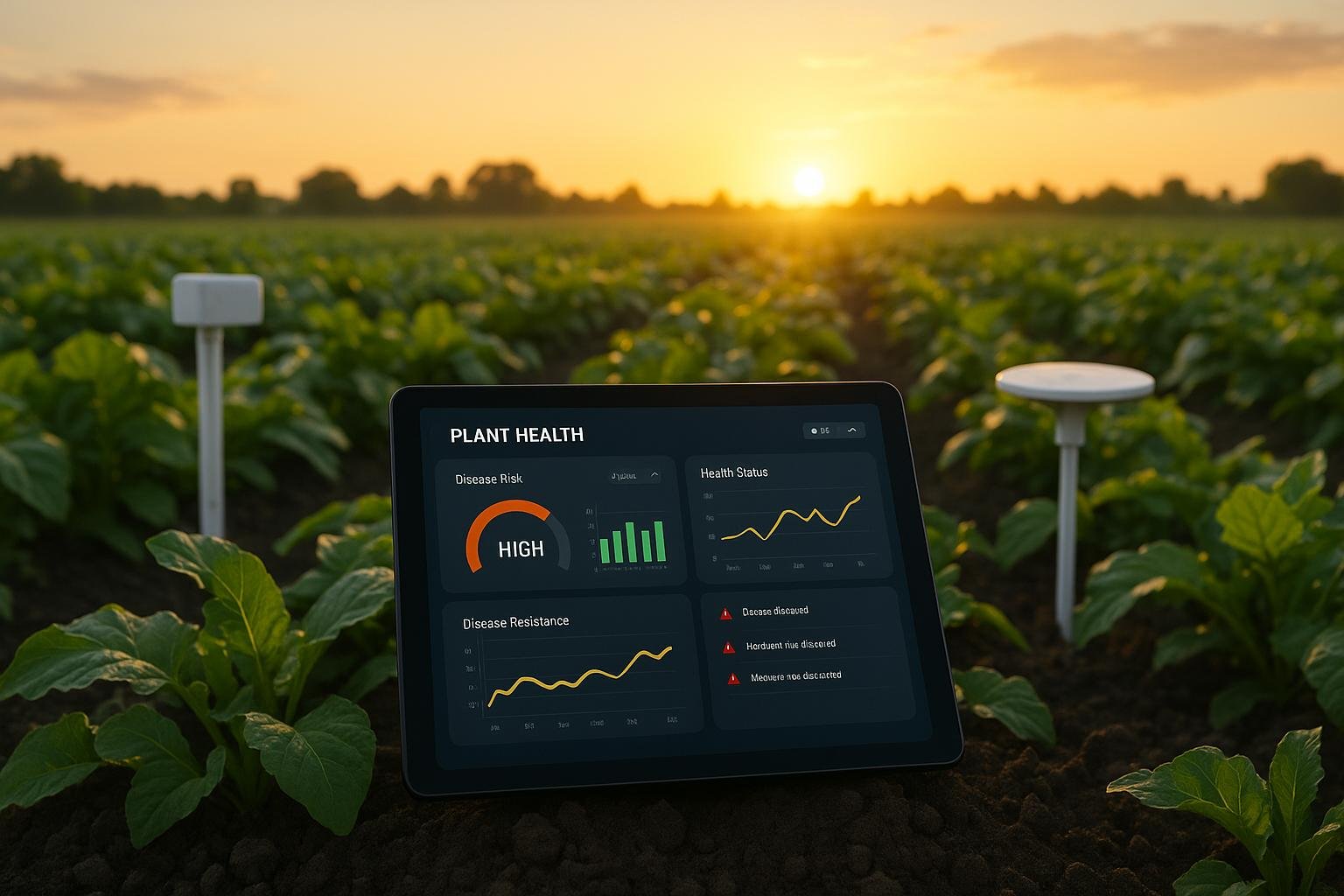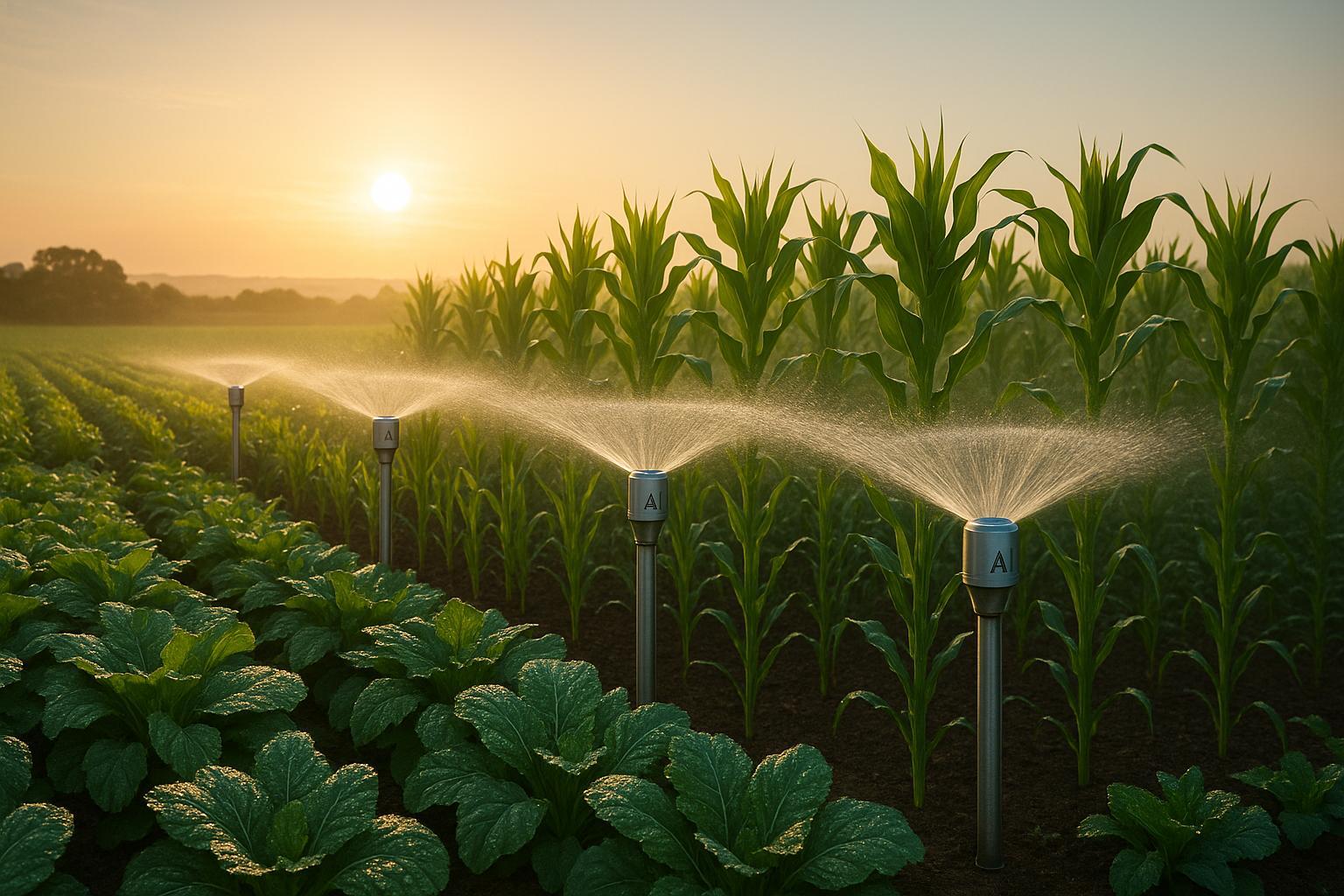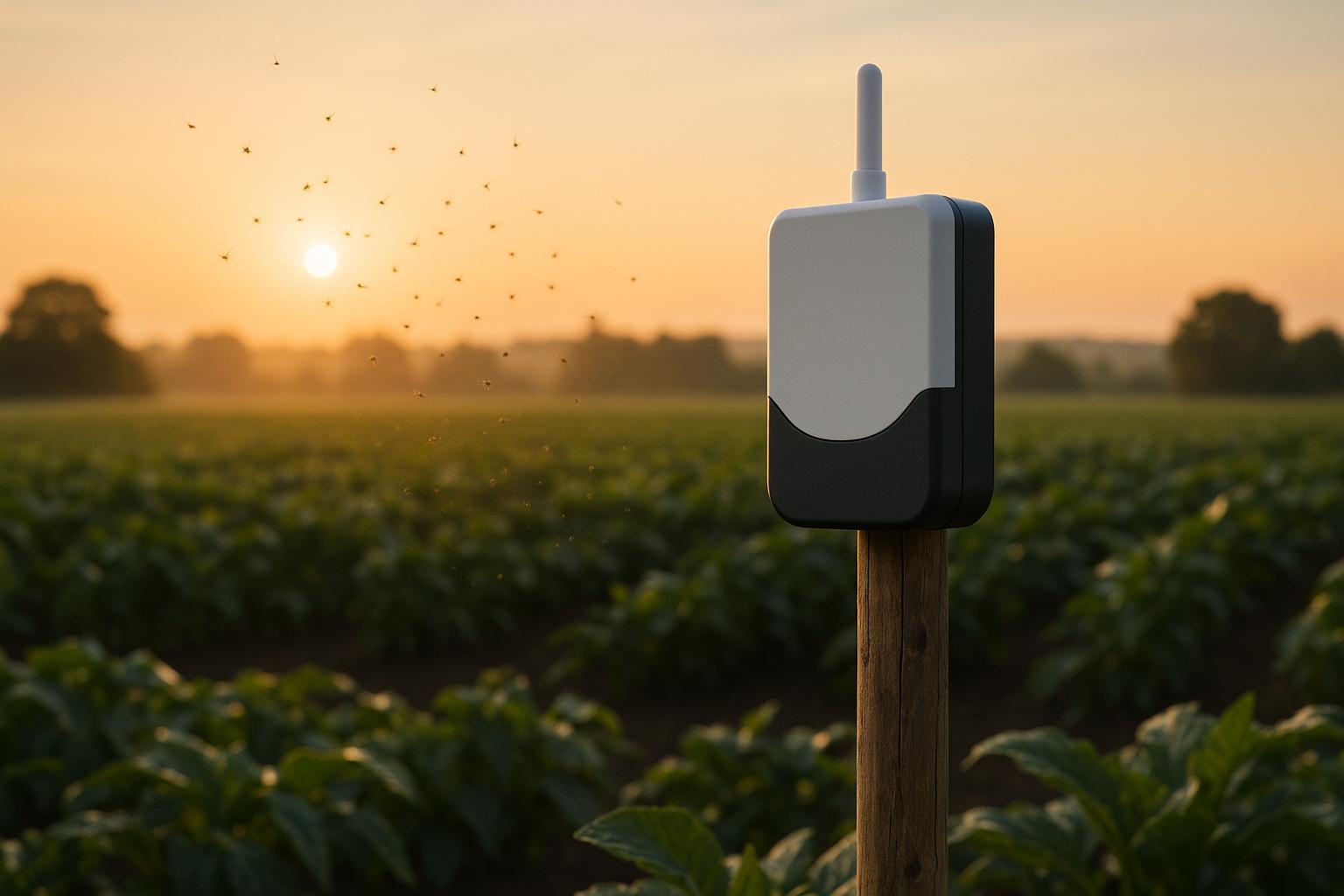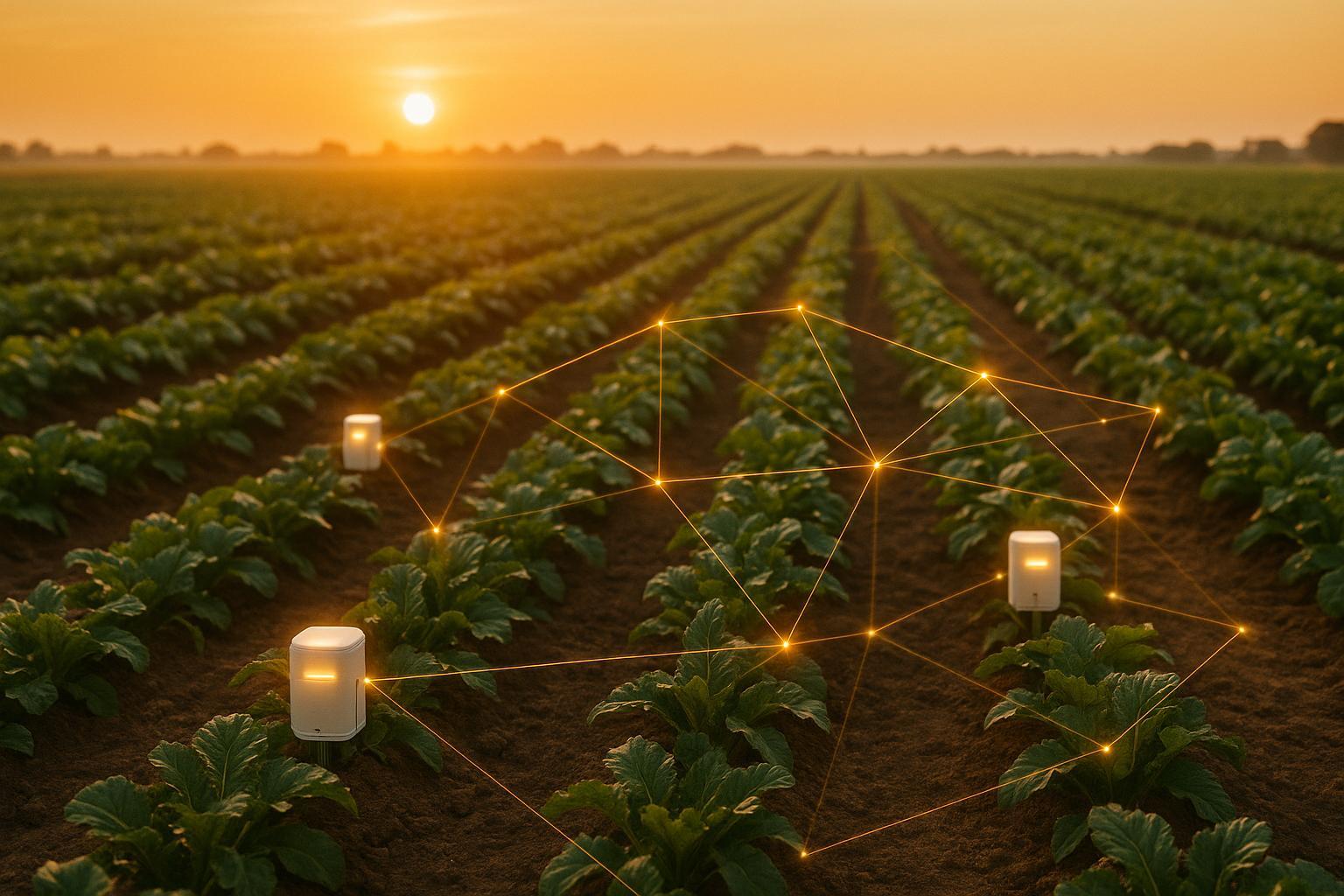IoT and AI for Disease Resistance Forecasting

Did you know plant diseases cause 20-40% of global crop losses every year? With the world population expected to reach 9.6 billion by 2050, improving how we predict and prevent these diseases is crucial. This is where IoT (Internet of Things) and AI (Artificial Intelligence) step in, offering tools to monitor and forecast potential outbreaks before they devastate crops.
Here’s what IoT and AI bring to the table:
- IoT Systems: Sensors collect real-time data on soil, temperature, humidity, and leaf health. This data helps detect early warning signs of disease.
- AI Models: Advanced algorithms analyze patterns in the data, predict outbreaks, and recommend targeted actions.
- Combined Benefits: Together, they reduce crop loss, lower pesticide use, and improve farm efficiency.
Quick Comparison
| Criteria | IoT Systems | AI Models |
|---|---|---|
| Primary Strength | Real-time monitoring | Predicting outbreaks |
| Cost | High hardware costs | Computational and software costs |
| Scalability | Limited by network infrastructure | Limited by data and computational power |
| Maintenance | Physical upkeep (sensors) | Digital upkeep (model updates) |
| Key Dependency | Quality sensors | High-quality datasets |
IOT based Plant Disease Monitoring Application

1. IoT Systems
IoT systems are transforming how we forecast plant diseases by using sensors to monitor various plant conditions. These sensors gather real-time data on factors like soil moisture, temperature, pH levels, and nutrient content. They also track environmental elements such as humidity, light intensity, and air temperature. Some advanced setups even capture leaf images to assess plant health, creating a robust foundation for detailed data analysis in later stages.
The data collected by these sensors is sent wirelessly through technologies like ZigBee, RFID, Wi‑Fi, GPRS, LoRaWAN, and cellular networks to centralized management systems or cloud platforms. This constant flow of information paints a clear picture of conditions that might lead to disease outbreaks, often identifying risks days or even weeks before visible symptoms appear.
Data Collection and Analysis
Once collected, the data is stored and analyzed to develop AI models capable of spotting patterns - such as specific combinations of temperature, humidity, and moisture - that indicate disease risks.
A noteworthy example comes from China, where researchers have integrated ozone sterilization, light traps, and IoT technologies into a unified system designed to prevent and manage crop diseases and pests. This approach has been successfully applied to crops like cucumbers, tomatoes, and rice.
Scalability and Cost Considerations
Scalability is a critical factor in IoT deployment. Modular designs and cloud-based processing make it easy to expand the system as farms grow. The global agricultural IoT market is expected to hit $13 billion by 2026, driven by systems that adapt to the changing needs of larger farms. For instance, John Deere has embedded IoT sensors into its farming equipment to optimize planting, harvesting, and other operations, improving both productivity and resource efficiency.
Implementation Challenges
Despite its promise, implementing IoT systems comes with hurdles. High upfront costs, connectivity challenges, and harsh environmental conditions demand rugged, industrial-grade equipment to ensure long-term reliability. Data management adds another layer of complexity, as organizations must establish clear policies for data ownership, compliance with regulations, and collection methods. Security is also a concern, with vulnerabilities in unencrypted wireless transmissions posing potential risks.
Practical Advantages
IoT systems offer a significant edge over traditional monitoring methods by reducing the need for manual inspections and lowering pesticide usage through continuous, cost-effective monitoring. Their precision enables farmers to intervene in specific problem areas rather than treating entire fields based on broad observations. This targeted approach not only minimizes waste but also improves the accuracy of AI models, thanks to the seamless flow of high-quality data.
2. AI Models
AI models play a crucial role in transforming the raw data collected by IoT sensors into actionable insights for disease resistance management. By analyzing environmental conditions, plant health metrics, and historical disease trends, these models provide precise forecasts about potential disease outbreaks.
Data Processing and Pattern Recognition
AI models excel at uncovering intricate patterns that might escape human observation. For instance, Convolutional Neural Networks (CNNs) have shown near-perfect accuracy in early disease detection, showcasing their ability to process complex data efficiently. Deep learning approaches combine image analysis with sensor inputs to automatically identify and classify disease symptoms - even before they become visible to the naked eye.
Prediction Accuracy and Model Performance
Different AI algorithms shine in various forecasting tasks. Random Forest models, for example, have achieved impressive AUC scores of up to 0.96 for predicting antimicrobial resistance patterns. Similarly, XGBoost models boast 95% accuracy in resistance prediction, outperforming many other methods. These high-performance metrics make these models highly practical for targeted disease management strategies.
Specialized Applications and Real-World Performance
Machine learning algorithms have proven to be valuable in reducing errors in agricultural treatments. A notable study using Logistic Regression, bootstrapping simulations, and gradient-boosting decision trees cut mismatched treatment rates to just 5.1%, a 42% reduction compared to traditional methods over a one-year period. Recurrent Neural Networks (RNNs) are particularly effective for analyzing sequential data, making them ideal for monitoring disease progression over time.
Scalability and Flexibility
AI models offer scalability advantages that traditional forecasting methods simply can't match. Unlike rule-based systems that need manual updates, machine learning algorithms continuously refine their predictions as they process more data. Algorithms like Support Vector Machines (SVMs) and Gradient Boosting Machines identify key risk factors and adapt to various farm sizes and crop types. The choice of model often depends on the specific application - neural networks are excellent for capturing complex environmental interactions, while decision trees offer straightforward, interpretable results that help farmers make informed decisions.
Implementation Challenges and Solutions
Despite their strengths, AI models face challenges in real-world applications. Issues like poor-quality or biased datasets and shifting environmental conditions can compromise reliability. There’s also the challenge of explainability - while decision trees provide clear reasoning for their predictions, more complex models like deep neural networks often operate as "black boxes", making their outputs harder to justify. Additionally, the lack of training and education in using these technologies remains a significant barrier, with many practical difficulties arising during deployment.
Integration with Existing Systems
For AI models to succeed, they must integrate seamlessly with existing farm management systems. This involves handling various data formats and communication protocols used by IoT sensors, which can pose interoperability challenges, especially when consolidating data from different manufacturers or updating older systems. The rapid evolution of AI technology also demands ongoing updates to ensure new solutions can be effectively incorporated into established frameworks.
🚀 Ready to Reinvent Your Garden?
Join thousands of homeowners who have transformed their gardens using our AI design tool. Upload one photo to explore endless possibilities.
Get your AI garden designs →Pros and Cons
Understanding the strengths and challenges of IoT systems and AI models is key for farmers deciding which technology best suits their disease resistance forecasting needs. Each offers distinct benefits while presenting unique hurdles, and comparing these technologies highlights their individual contributions.
IoT Systems: Real-Time Data Collection
IoT systems excel at continuously monitoring environmental factors like temperature, humidity, and soil moisture - critical data for predicting disease outbreaks.
One major advantage of IoT systems is their ability to automate data collection, reducing the need for manual labor and ensuring consistent, unbiased data streams. This automation forms the backbone of accurate disease predictions.
However, IoT systems come with notable challenges. The hardware - sensors and devices - can be expensive, especially for large-scale operations. Beyond the initial investment, ongoing costs include sensor calibration, replacing devices, and addressing data security concerns when transmitting sensitive farm information.
AI Models: Advanced Pattern Recognition and Predictions
AI models shine at transforming raw data into actionable forecasts. They analyze large datasets to uncover patterns that may be too subtle for humans to detect. For instance, a study by Kanjilal et al. demonstrated AI's predictive power: analyzing electronic health records from 10,053 patients with uncomplicated urinary tract infections, the model reduced second-line antibiotic use by 67% when tested on 3,629 additional patients.
Another strength of AI is its ability to improve over time. Machine learning algorithms adapt as they process more data, making them particularly effective in dynamic environments where conditions and pathogen behaviors frequently change.
However, AI models are heavily reliant on high-quality, diverse datasets to avoid bias and ensure accuracy. Poor or incomplete data can compromise their reliability. Additionally, the complexity of these models can make their decision-making processes less transparent, which may deter some users.
Cost, Scalability, and Maintenance Considerations
The financial requirements for these technologies differ significantly. IoT systems involve high upfront hardware costs but can lead to long-term savings by enabling early disease detection and more efficient resource use. On the other hand, AI systems focus more on software and computational infrastructure, requiring ongoing investments in skilled personnel and model updates.
Scalability also presents different challenges. IoT systems are limited by network infrastructure and data storage, while AI scalability depends on computational power and algorithm sophistication.
Both technologies demand regular maintenance. IoT systems require physical upkeep, such as sensor calibration and hardware replacements. Meanwhile, AI models need continuous digital maintenance, including refining algorithms, monitoring data quality, and updating models to stay effective.
AI-powered precision agriculture has shown impressive results, such as increasing crop yields by up to 30% and reducing water usage by 20–50%. The AI in agriculture market is expected to grow at a compound annual growth rate of 25.5% between 2020 and 2026, reaching $4 billion. Despite these promising figures, practical implementation is not without hurdles. Many farmers face gaps in technical training, and the fast pace of technological advancements requires constant updates to ensure compatibility and performance.
| Criteria | IoT Systems | AI Models |
|---|---|---|
| Primary Strength | Real-time data collection and monitoring | Pattern recognition and predictive power |
| Cost Structure | High sensor costs and maintenance | Software-focused with computational costs |
| Scalability | Limited by network and storage capacity | Limited by computational and algorithmic needs |
| Maintenance | Physical upkeep (e.g., sensor calibration) | Digital upkeep (e.g., model refinement) |
| Data Quality Dependency | Generates large volumes but needs quality sensors | Relies on diverse, high-quality datasets |
| Implementation Complexity | Requires hardware and network setup | Needs advanced algorithm development |
The most effective disease resistance forecasting systems integrate both technologies. By combining IoT's reliable data collection with AI's powerful analytics, farmers can address the limitations of each approach and create comprehensive solutions to meet modern agricultural challenges.
sbb-itb-4d6a8dd
Conclusion
When it comes to combining IoT systems and AI models, the key is finding a balance that aligns with your goals, budget, and technical know-how. By blending these technologies thoughtfully, you can create a more efficient and effective garden management system.
IoT sensors provide real-time data on factors like soil moisture, temperature, and humidity, which can trigger automated actions. While the initial investment may be higher, the long-term benefits of automation and real-time insights are undeniable. On the other hand, AI models excel at turning data into accurate forecasts, though they require quality datasets and regular updates to remain effective.
By integrating IoT's real-time monitoring with AI's predictive capabilities, you can overcome the limitations of each technology. Together, they form a powerful toolkit for managing your garden with both precision and efficiency.
"Precision agriculture transcends merely adopting new technologies; it establishes a more precise and sophisticated farm management system" – Professor Pierre C. Robert
If you're just starting out, begin with a simple IoT setup and set clear, achievable goals. Expand your system as you gain experience and confidence. Keep in mind that costs can vary widely - from budget-friendly options under $100 to more advanced systems that require a larger investment.
The agricultural technology market has proven its ability to tackle real-world farming challenges. However, the success of these tools depends on proper setup, consistent maintenance, and a deep understanding of your garden's unique needs.
FAQs
How do IoT and AI work together to predict and prevent plant diseases?
How IoT and AI Work Together to Protect Plants
The combination of IoT devices and AI systems is transforming how we safeguard plant health. IoT tools like sensors and cameras keep tabs on essential environmental factors - think temperature, humidity, and soil moisture - while also monitoring the overall condition of plants. This steady stream of real-time data is then handed over to AI for analysis.
Here’s where it gets interesting: AI uses machine learning to study patterns in the data, spotting early signs of potential disease risks. Over time, the system gets better at predicting issues by learning from new information. It can even send out predictive alerts to warn growers when conditions are ripe for disease, giving them the chance to act quickly and prevent problems before they escalate.
By working together, IoT and AI are making disease management smarter and more efficient, helping growers stay one step ahead.
What challenges do farmers face when using IoT and AI to predict plant disease resistance?
🎨 Visualize Your Dream Garden Today!
Transform any outdoor space into a professional landscape design in minutes. Just upload a photo, choose your style, and let our AI do the rest.
Start your garden transformation now →Challenges Farmers Face with IoT and AI in Disease Resistance Forecasting
Farmers face a range of obstacles when trying to adopt IoT and AI technologies for predicting disease resistance. One of the biggest challenges is the technical complexity of these systems. For farmers without a background in technology, understanding and managing these tools can feel overwhelming.
Another significant barrier is the high initial investment required. The cost of purchasing and setting up IoT devices and AI tools can be a major strain, especially for small-scale farmers who often operate on tight budgets.
The quality and availability of data also play a crucial role. These technologies rely heavily on accurate, consistent data to make reliable predictions. Unfortunately, accessing such data isn’t always easy or guaranteed. On top of that, many farmers find it difficult to blend these modern technologies with their existing farming practices, which can lead to reluctance or even resistance to adopting them.
Finally, poor infrastructure in rural areas, like unreliable internet connectivity, adds another layer of difficulty. Without stable internet access, implementing and using these advanced solutions becomes nearly impossible for many farmers.
How can farmers improve the quality of datasets for AI models to enhance disease resistance forecasting?
How Farmers Can Improve AI Datasets
To ensure AI models deliver accurate and actionable insights, farmers should focus on a few essential practices when building datasets:
- Gather a variety of relevant data: Pull information from multiple sources like IoT sensors, weather stations, and soil tests. This helps create a well-rounded dataset that reduces bias and improves reliability.
- Maintain consistent data formats: Standardize formats and definitions across all collected data to avoid compatibility issues and ensure accuracy.
- Clean and validate data regularly: Eliminate errors, duplicates, and irrelevant entries to keep the dataset reliable and ready for analysis.
By adopting these practices, farmers can develop higher-quality datasets, enabling AI models to better support decisions in managing plant disease resistance.
Related posts
Related Articles

How Microclimates Affect Plant Placement Decisions
Learn how microclimates influence plant growth and discover effective strategies for optimal plant placement in your garden.

Checklist for AI-Optimized Irrigation
Explore how AI irrigation systems enhance water efficiency, boost crop yields, and simplify garden management through smart technology.

Ultimate Guide to Acoustic Pest Monitoring
Explore acoustic pest monitoring, a sound-based method that detects pests early, reduces pesticide use, and enhances garden management with AI.

IoT Sensors for Pest Monitoring: Real-Time Data Explained
Explore how IoT sensors are revolutionizing pest monitoring in agriculture, providing real-time data for smarter, eco-friendly pest control.

AI Climate Analysis for Plant Selection
Explore how AI is revolutionizing gardening by providing tailored plant recommendations based on local climate and conditions, ensuring resilient gardens.

IoT Pesticide Networks: Data Security Risks
Explore the cybersecurity risks facing IoT pesticide networks in agriculture and discover effective strategies to enhance data security.